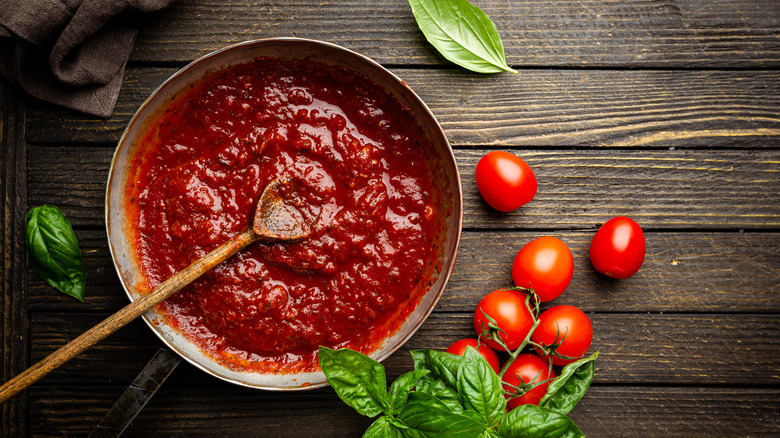Andrew Zimmern's Secret To A 'Bright, Flavorful Red Sauce'
One of the most heated debates over the past century can be summed up in just three words — Sauce or Gravy? Historians have attempted to figure out the origin of this cultural divide with no success (via Slate). "I just think there are some things that cannot be proved by science," Lorraine Ranalli, author of the book Gravy Wars, told Slate.
Italian-Americans have been split since immigrating to the U.S. whether what you pour on pasta is called sauce or gravy. Made famous by the HBO drama "The Sopranos," gravy is primarily used by Italian-Americans living in areas settled earlier by Italian immigrants. That includes New York and New Jersey, and southern regions like New Orleans, Louisiana. Often prepared on a Sunday and slow-cooked for hours, gravy is a tomato sauce that can be filled with a combination of meats, like meatballs, sausage, pork ribs, and braciole.
Andrew Zimmern is no stranger to addressing heated debates like gravy versus sauce. On his podcast with Molly Mogren, the "Bizarre Foods" star has tackled important controversies before, like "Hero, Hoagie, Sub or Grinder?" Recently, on his weekly Substack video series called "Spilled Milk," where Zimmern answers viewer questions about food, travel, or anything he finds educational, amusing, or interesting, Zimmern describes how he makes a bright, flavorful red sauce, letting us know where he stands on the debate.
Adding meat will change up your sauce
A first-generation viewer from Sicily that recently immigrated to New Jersey, asks Zimmern on "Spilled Milk," his take on the gravy or sauce debate, prompting Zimmern to educate us on the science of sauce. In the video, Zimmern explains that quickly cooking the tomato sauce without adding meat will keep the sauce more brilliant, but it also remains more acidic. He says that adding meat and slow-cooking the sauce all day will add a sweetness to the sauce but also change the color, making it darker.
Zimmern took to Twitter to demonstrate how he makes his marinara sauce. Within roughly 25 minutes, he takes puréed tomatoes, tomato paste, fresh basil, dried oregano, sugar, wine, onion, and garlic, and transforms them into a bright red sauce, perfect for Sunday's macaroni. The chef warns viewers when cooking the onion and garlic to add the aromatics to warm, not hot, oil to keep them from burning and turning bitter. This simple tomato sauce is an essential recipe every home cook should know, according to Zimmern, and can be used in dishes like pizza, lasagna, and chicken parmigiana.
Now that the sauce is taken care of, Lidia Bastianich can help you pick the perfect pasta to complement it, just remember not to drown it in the sauce. Sara Jenkins of NYC's "Porchetta" explains, "After you've eaten the pasta, there should be just enough sauce left in the bowl to swipe a small piece of crusty bread through."

